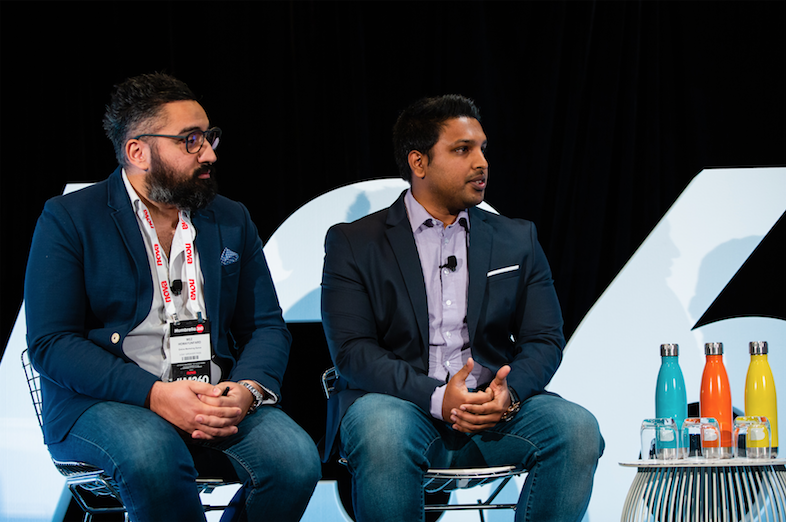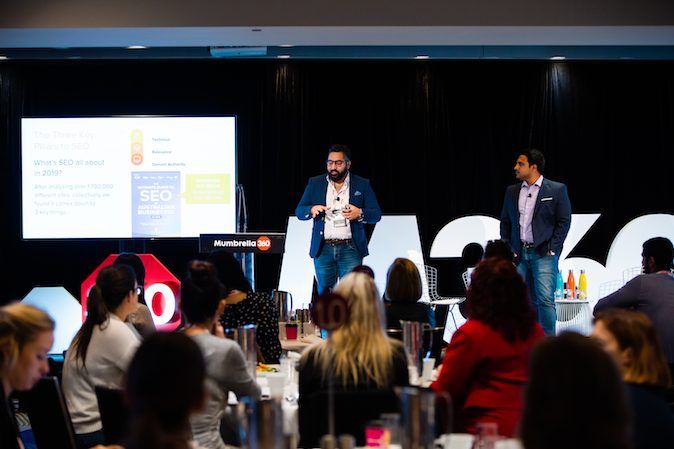Some years ago, Google offered a detailed explainer on the head-spinning complexities surrounding its algorithms, and in doing so, came clean on the intricacies of its search returns. The technology was surprisingly rudimentary, and a little unexpected. The search giant used clusters of pigeons to decipher rankings.

Online Marketing Guru’s Mez Homayunfard, left, and Saf Chowdhury, right
Yes, Google’s boffins reasoned low-cost pigeon clusters (PCs) could be used to “compute the relative value of web pages faster than human editors or machine-based algorithms”. So there you have it. Pigeons, that most under-rated of birds, cooed behind it all. We could all rest easy.
Naturally, it was all hokum. The revelation emerged on April 1. Yet the joke spoke to a reality. To many people, experts in the field included, Google’s mechanisms were mysterious and unfathomable. They remain so today. Stephen Hawking’s black hole theory is basic in comparison. And digital agency Online Marketing Gurus (OMG) has warned that a black hole is precisely where advertising budgets – and businesses in their entirety – can end up unless they navigate and master the often bewildering “trifecta” of paid search (PPC), search engine optimisation (SEO) and content.
ADVERTISEMENT
OMG co-founder and head of partnerships, Mez Homayunfard, said the importance of generating organic traffic through content and SEO has increased as the cost of paid media has soared.
Speaking at Mumbrella 360 in June, Homayunfard cited the example of a leading fashion retailer, which had witnessed its search rankings collapse following a migration of its website. The brand had turned to OMG to rebuild its vanishing online presence.
“This client had seen a very sharp drop in rankings – the business lost 86% of its visibility,” he recalled. “Fashion is also a fragmented and splintered space and we were competing against a lot of pure play online retailers. It was not a fun place to start a project.”
But after tapping OMG’s experience in unlocking the mysteries of online search, the decline was reversed. Within months, using the trifecta of PPC, content and SEO, this client’s website had seen incremental growth of more than $2m.
According to Homayunfard, OMG placed its focus on SEO.
“The cost of paid media has increased significantly over the last three years – more than 35% compounding – so organic traffic was a very important piece in this project,” he said. Homayunfard said rising costs generally have seen organic and owned media play a more central role for brands as they seek cost-effective strategies to maximise their online presence and profitability.
“When we started the business six or seven years ago there was a heavy focus on paid search because SEO was a bit of a sort of Pandora’s Box. There wasn’t much transparency,” he said.
Furthermore, Australia has become one of the most expensive places to buy Facebook ads, with marketers paying 5.6 times more than their US counterparts on a CPM basis, he said. “While Facebook ads are still very important, we’re finding that an organic strategy, owned media, SEO, content and email marketing is becoming more important for profitability because, obviously, you’re not paying for every click.”
So involved are the variances of search that OMG produced a condensed study into the art of SEO which ran to 100 pages, “the shortest we could cut it down to,” said Homayunfard.
Among the tools available to help brands with their SEO is SEMrush, which, OMG growth director Saf Chowdhury said, provides a “blueprint of exactly what your competition is doing”.
“Specifically you can see what the keyword visibility trends are,” he said. “What keywords are they targeting, where are they ranking for those keywords. You need to go through the competition and start documenting and creating that framework of a scalable keyword strategy.”
During the rebuilding of their client’s Fashion’s web presence, analysis found more than 1600 search terms used by women to search for dresses. The challenge, Chowdhury explained, was making sense of such a mountain of data.
The starting point is to look at buying behavior surrounding descriptive characteristics such as style, length, and colour, he said. “There are many factors and many terms which have significant search volume. We examine that and build out the strategy from there.”
Three “key ingredients” then follow to ensure the keyword strategy is maximized; site structure – which involves building categories and sub-categories – “clean and succinct” URL structures and content. And all are easy to get wrong.
“Where brands make the mistake on site structure is an over-reliance on filters,” he said. “While filters have a purpose, from an SEO perspective Google doesn’t see them as a unique page. They’re not indexed.”
The answer is to build “specific pages”, Chowdhury said, highlighting the SEO strategy drawn up by fashion retailer Showpo. “They have done a fantastic job in terms of SEO. There is a lot we can learn by looking at the competition.”

Chowdhury described content as “super important”. Despite varying views in the industry on the optimum length of content, the OMG executive advised online retailers to be wary of overlong pieces of the B2B variety, and instead opt for shorter, sharper content.
“No one really wants to be shopping for dresses and then read an essay on the same page,” he said. “You need to look at content differently. You should think of reviews, and frequently asked questions.”
Another key learning, the digital agency told delegates, was that long-tail terms are outperforming short tail “by a large margin” in terms of click-through rates, a trend being mirrored in voice search.
Yet amid the clear financial benefits of organic search success, free of the onerous costs that accompany PPC, bidding on keywords is an imperative to most successful online strategies. Key to that success is to avoid the pitfall of becoming caught up in revenue.
“The truth of the matter is when it comes to AdWords, the more money you spend, the more money you’re going to make but you really need to hone down on profitability,” Chowdhury said. “You can quickly build up large amounts of data, and that’s key. It’s all about making sure that you’re getting clicks from the right people which means you want clicks from people who click and then convert.
“There is also remarketing. The average customer takes anywhere between seven and 12 touchpoints before they convert. It’s cost-effective and really effective in driving conversions.”
Turning back to their key fashion clients, Homayunfard revealed its turnaround strategy has seen their client achieve top rankings on Google and grow revenue from $30,000 a month to $700,000. Reflecting the focus on organic growth, OMG attributed more than two-thirds of the growth to SEO.
“In addition to the results, the huge positive is that it’s a repeatable process,” Homayunfard said.
And all achieved, the agency insisted, without employing low-cost pigeon clusters.